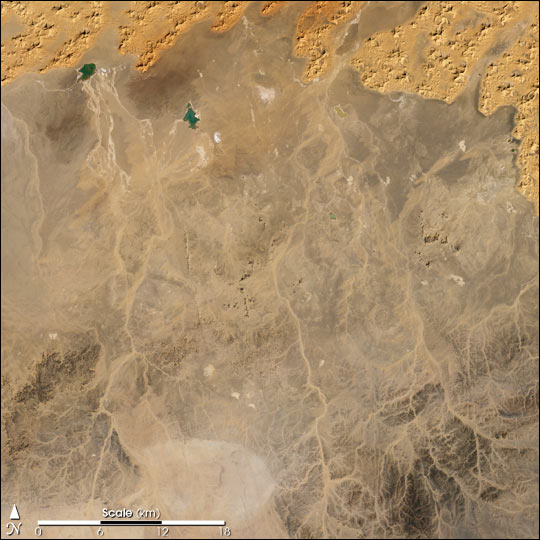
Saharan Wadis
Downloads
- algeria_ls5_1987001_lrg.jpg (3096x3096, JPEG)
Metadata
- Sensor(s):
- Landsat 5 - TM
- Data Date:
- Visualization Date: September 20, 2002
The Sahara Desert covers most of the North African country of Algeria. Rainfall is scarce, and it comes and goes rapidly, flowing through channels called wadis. When dry, as they are in this true-color Landsat Thematic Mapper image from January 1, 1987, the wadis are revealed as pale tracings across the darker brown and gray shades of the desert landscape. In many cases, these wadis end in small pools which have no outlet. The water flows in from the wadis and gradually evaporates, leaving behind salts and other minerals which appear white in this image. At the upper left of the image, a few pools of bright blue-green water are hanging on despite the aridity, their greenish color probably due to high salt and mineral content, or perhaps the growth of algae.
Wadis are prime breeding locations for populations of the desert locust, which inhabits vast desert areas across northern Africa, Arabia and southwest Asia. Moisture initiates the hatching of the locusts’ eggs and also brings a bloom of fresh vegetation, which provides food and a place for the insects to hide from predators. Normally, the locust prefers a solitary existence, but when suitable habitat is confined to small areas, such as narrow wadis, large numbers of locusts may be forced to congregate. Close physical contact flips a biological switch in the locusts’ metabolism and behavior that makes them more tolerant of each other and enhances swarming. Locust swarms can migrate hundreds of miles and devour all vegetation in their path. Monitoring desert habitat for changes in vegetation using satellite data gives scientists the opportunity to anticipate where swarms might be forming and to direct ground-based survey crews with increased efficiency.
(Image by Robert Simmon, NASA GSFC, based on Landsat Thematic Mapper data archived by the Global Land Cover Facility)
This image record originally appeared on the Earth Observatory. Click here to view the full, original record.